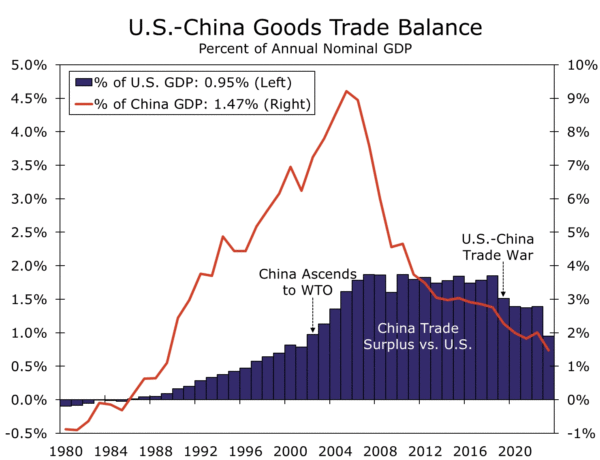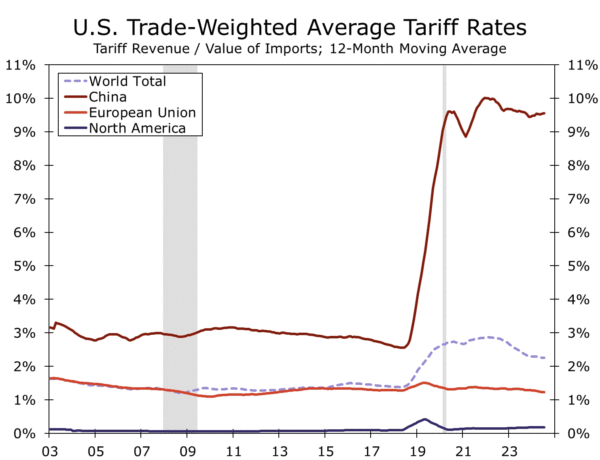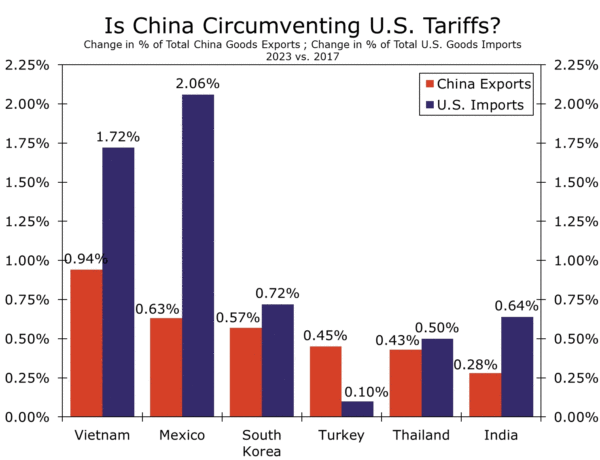Summary
We have written extensively about the deterioration in the trade relationship between the U.S. and China, and how tensions between the two nations have rewired global trade patterns. Following the implementation of Trump-era tariffs, the U.S.-China trade relationship reached an inflection point, and as of the end of 2023, China’s trade surplus with the United States was essentially half of what it was relative to before the trade war. However, a deeper dive into global trade flows suggests the overall U.S.-China trade relationship may not necessarily be weakening as much as data suggest. Evidence exists that China may be circumventing U.S. tariffs via proxy nations, and still benefiting from U.S. demand and the United States as a final export destination. In this report, we highlight how the composition of U.S. import partners has changed over time. We also reveal how China’s export destinations have also changed, and the same countries the U.S. is importing more from, China is exporting more to.
Coincidence? Probably not.
China Is Paying Tariffs, But Also Working Around Them
Over the last few years, we have written extensively about the deterioration in the trade relationship between the U.S. and China. More recently, we explored how tensions between the two nations have spread and are upending trade relationships around the world and rewiring global trade patterns. U.S.-China relations have been tense for some time due to diverging strategic priorities and geopolitical differences; however, we can pinpoint the inflection point—at least for trade—as the implementation of Trump-era tariffs and the broader trade war that originated in 2018. To that point, China’s trade surplus with the United States saw a meaningful dip when tariff rates ramped up over the course of 2019 (Figure 1). Successive years have seen China’s trade surplus slip even further, and as of the end of 2023, China’s trade surplus with the United States was essentially half of what it was relative to before the trade war—both in terms of U.S. and China GDP. We can point to many other metrics to indicate the U.S.-China trade linkage is not as robust as it once was; however, a deeper dive into global trade flows tells an interesting story. One that suggests the overall U.S.-China trade relationship may not necessarily be weakening as much as data suggest. The same global trade data also suggest that China may be circumventing U.S. tariffs, and still benefiting from U.S. demand and the United States as a final export destination.
As background, President Trump first imposed tariffs directly on Chinese exports in 2018. Over the course of the next few years, tariffs were imposed on a majority of Chinese exports to the U.S., while the tariff rate being applied was ratcheted higher. China responded with retaliatory tariffs on all U.S. exports to China, and matched tariff threats emanating out of the United States. Eventually, the U.S. and China reached a “Phase 1” trade deal that saw future tariff hikes suspended and the tariff rate imposed on select goods lowered. For the time being, the “Phase 1″ trade deal remains intact; however, the Biden administration has imposed additional tariffs—along with broader restrictions—on certain exports to China over the course of the last four years. While Chinese authorities have not responded with new tariffs, China has erected other forms of trade barriers with the U.S. that contribute to the complications surrounding the U.S.-China trade relationship. As far as tariff revenue, at least for the United States, the U.S. is collecting a sizable amount of revenue derived from the tariffs imposed on China. As of mid-2024, the trade-weighted average tariff rate (i.e. tariff revenue as a percent of the total value of U.S. imports from China) on China is ~9.5%, a notable step up from the tariff rate prior to the trade war (Figure 2). Excluding the distortion caused by COVID-19 in 2020, the average tariff rate on imports from China has slipped only modestly over the last few years. The moderate decline in this ratio is mostly a product of reduced U.S. demand for Chinese goods subject to tariffs, in particular.
However, Figure 2 also shows an average U.S. trade-weighted tariff rate on imports from the entire world, which may be a more compelling data point as well as evidence that China may be circumventing U.S. tariffs. For clarity, when we say “circumventing U.S. tariffs”, we are referring to China using proxy nations as a way of avoiding U.S. import duties on goods produced in and sent directly from China. These “proxies”—either other low-cost economies in Southeast Asia, nations geographically or geopolitically close to the U.S. etc.—are used as intermediaries before Chinese manufactured products eventually reach U.S. soil. But as far as the world tariff rate and how that corresponds to China’s use of proxy nations, the world tariff rate popped higher during the peak of the trade war, but has steadily fallen over the last few years. While the world tariff rate may be slightly diluted from the value of overall U.S. imports rising, the larger influence over the fall in the world tariff rate is less total tariff revenue collection in absolute dollar terms, given a compositional shift in U.S import partners. As reflected in the narrowing China trade surplus chart, the U.S. is importing less from China, the United States’ main source of tariff revenue. Instead, the U.S. is sourcing an increased amount of goods from other nations in Asia as well as across Latin America and Europe. Relative to 2017, the U.S. is importing significantly more goods from countries such as Vietnam, Mexico, South Korea, Turkey, Thailand and India (Figure 3). Essentially, countries not subject to China-style tariffs. At the same time, global trade data reveal that China has also boosted trade relations with those same nations. As of the end of 2023, and relative to before the trade war started, China is exporting more goods to those very same countries.
Coincidence? Probably not. Take Mexico for example. Mexico is widely considered to be one of the top nearshoring destinations for U.S. corporations looking to shift critical supply chain links out of China. As U.S. multinational corporation interest in nearshoring picked up after tariffs were imposed and surged again after COVID-19, so has Chinese foreign direct investment (FDI) into Mexico (Figure 4). Without knowing for certain, there is a high likelihood China is actively putting infrastructure on the ground in Mexico as an intermediary to accept Chinese made goods before ultimately sending on to the United States. Indeed, given the shifting composition of trade flows and China’s increased foreign direct investment activity, we would argue the evidence strongly suggests that a perceptible portion of China-U.S. trade flows are being re-routed via proxy countries. The Biden administration indeed took notice of these tactics, and recently applied tariffs to certain Chinese goods making their way into the U.S. via Mexico. China using proxy nations as means to avoid U.S. tariffs will likely retain the attention of the current administration and a potential Democratic administration post-elections, but could also be at the core of former President Trump’s proposed “global tariff.” Should a tariff on all exports to the United States apply to all nations, the ability for China to completely circumvent export duties would be diminished. While a U.S. global tariff would place downward pressure on global growth and upward pressure on global inflation, as well as potentially damage relations between the U.S. and most trading partners, the genesis of former President Trump’s global tariff proposal could still be aimed at disrupting China’s rise. Combined with Trump’s proposed 60% tariff on exports to the U.S. directly from China, China’s ability to tap U.S. consumer demand could be at risk should U.S. trade policy turn more protectionist in the near future. With exports propping up China’s economy for the time being, a global tariff alongside tariffs imposed directly on China could have a more severe impact on China’s economy relative to existing tariffs. While we are not assuming any new tariffs or changes in U.S. trade policy in our global economic forecasts, we do feel comfortable saying that U.S.-China tensions will persist for an extended and ongoing period of time, even in a scenario without new tariffs. We also feel comfortable sharing our view that U.S.-China decoupling that has been underway for a period of time, as well as the fragmenting of the global economy to align with either the U.S. or China, is likely to continue for the foreseeable future.
















